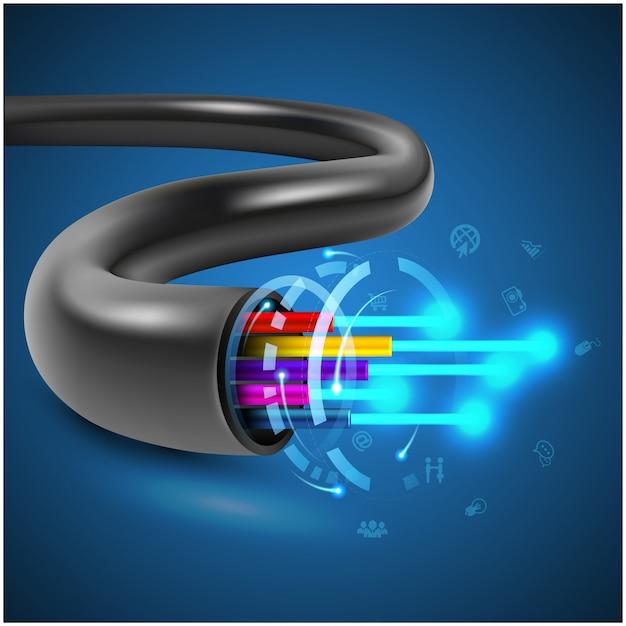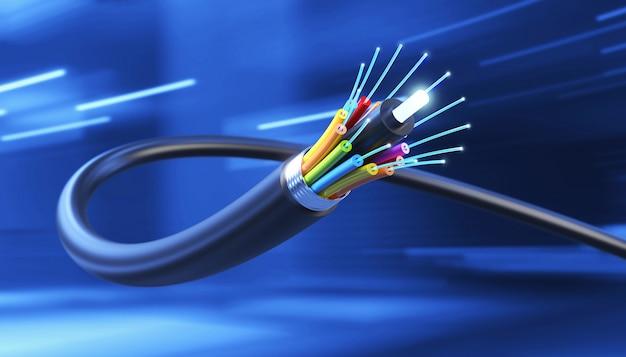Optical fiber is a crucial technology that has revolutionized communication systems by transmitting information with light pulses. You might wonder why optical fibers have a core surrounded by a cladding material. The reason lies in the fundamental need to maintain the signal’s integrity and maximize transmission efficiency.
In this blog post, we will explore the purpose of cladding in optical fiber and delve into its significance. We will also address common questions such as the differences between single-mode and multimode fiber, the working wavelengths of 1310nm and 1550nm, the applications of 4 core fiber cables, and how to identify single-mode or multimode fiber cables. Are you ready to unlock the secrets behind optical fiber cladding?
So without further ado, let’s dive into the world of optical fibers and discover the role of cladding in ensuring effective data transmission.

Why is Cladding Used in Optical Fiber?
Cladding – it may sound like something out of a sci-fi movie, but it’s actually a crucial component of optical fibers. So why exactly is cladding used in optical fiber? Well, grab your magnifying glass because we’re about to dive into the microscopic world of fiber optics!
What is Optical Fiber Cladding
Before we unravel the mystery, let’s start with the basics. Optical fiber is a hair-thin strand of glass or plastic that carries information in the form of light pulses. Think of it as the superhighway for data, allowing us to binge-watch our favorite shows and browse endless memes at lightning-fast speeds.
The Inner and Outer Layers: Core and Cladding
Now, let’s talk about the dynamic duo at the core of optical fiber. The inner layer, appropriately called the core, is where the magic happens. It’s the pathway that carries the light signals, guiding them on their merry way. But hey, even light needs a wingman, right? Enter the cladding, the outer layer that surrounds the core like a loyal sidekick.
The Battle Against Loss: Total Internal Reflection
So, what’s the big deal with cladding? Well, it turns out that light is a bit of an escape artist. If left to its own devices, it would try to break free from the core and leak out like a mischievous little daredevil. But fear not! The cladding is here to save the day.
Trapped Inside: The Power of Refraction
The cladding has a lower refractive index than the core, which means it bends light inwards and keeps it tightly confined within the core. This clever trick is known as total internal reflection. It’s like a miniature laser show happening within the fiber, with the light bouncing off the cladding walls, unable to escape.
Loss Prevention: Say No to Signal Degradation
By ensuring that light stays inside the core, cladding helps prevent signal loss and degradation. Think of it as the superhero cape that shields our precious light signals from the perils of the outside world. Without cladding, our optical fiber connections would be about as effective as shouting Morse code into a crowded room.
A Twist in the Tale: Single-mode and Multimode Fiber
Here’s where things get interesting. Cladding isn’t a one-size-fits-all solution. Different types of optical fiber use different cladding strategies. In single-mode fiber, the inner core is ultra-thin, and it requires a specialized cladding to keep those light signals in check. On the other hand, multimode fiber has a larger core, allowing multiple signals to travel simultaneously.
Conclusion: Cladding to the Rescue
So, in a nutshell, cladding is used in optical fiber to ensure that light stays where it should be – inside the core. By cleverly harnessing the power of refraction and total internal reflection, cladding keeps our data flowing, our streaming uninterrupted, and our internet browsing snappy. Next time you’re zipping through the internet at warp speed, take a moment to appreciate the unsung heroics of cladding in optical fiber. Cheers to technology, nerds, and the tiny miracles happening in our fiber optic cables!
beamed out by our trusty internet provider.

FAQ: Why is Cladding Used in Optical Fiber?
In this FAQ-style section, we’ll address some common questions about the use of cladding in optical fiber. From the basics of fiber optic communication systems to the differences between single mode and multimode fibers, we’ve got you covered!
What Are the Basic Elements of a Fiber Optic Communication System
At its core, a fiber optic communication system consists of three main elements:
- Transmitter: This device converts electrical signals into optical signals that can travel through the fiber optic cable.
- Fiber Optic Cable: The cable itself, made up of a core and cladding, serves as the conduit through which the optical signals travel.
- Receiver: This device receives the optical signals and converts them back into electrical signals for further processing.
What Is the Difference Between 1310 and 1550
1310 and 1550 refer to the wavelengths of light used in fiber optic communication. The key difference lies in their applications:
- 1310nm: This wavelength is commonly used in multimode fiber for shorter distance transmissions. It offers higher data rates and greater bandwidth.
- 1550nm: This wavelength is predominantly used in single mode fiber for long-distance transmissions. It provides lower attenuation and is more suitable for high-capacity networks.
Is Single Mode Fiber Better Than Multimode
When it comes to choosing between single mode and multimode fiber, it depends on your specific requirements. While single mode fiber excels in long-distance transmission, multimode fiber is ideal for shorter distances. Each has its strengths, so it’s essential to consider factors like distance, bandwidth, and cost to determine which is better for your needs.
Is 1310 Single Mode or Multimode
1310nm light can be used in both single mode and multimode fiber, but its primary use is in multimode fiber for shorter distances. Multimode fiber allows for multiple modes or paths for light to travel through, while single mode fiber allows only one mode or path.
What Is a BiDi SFP
BiDi SFP, short for Bidirectional Small Form-Factor Pluggable, is a type of optical transceiver module used in fiber optic networks. It supports bidirectional communication over a single fiber optic cable by using different wavelengths for transmission and reception. It efficiently doubles the capacity of existing fiber infrastructure.
What Is a 4 Core Cable Used For
A 4 core fiber cable refers to a cable that contains four separate optical fibers within its structure. These cables are commonly used in applications where multiple independent fiber connections are required, such as telecommunications, data centers, and network backbone installations.
How Far Can Single Mode Fiber Go
Single mode fiber can transmit data over incredibly long distances, ranging from tens to hundreds of kilometers. Its low attenuation and ability to maintain signal integrity make it ideal for long-haul communication links and intercontinental network connections.
How Do I Know If My Fiber Cable Is Single or Multimode
Identifying whether a fiber cable is single mode or multimode can be determined by checking its specifications or markings. Single mode fiber typically has a yellow jacket, while multimode fiber often has an orange, aqua, or gray jacket. Additionally, the cable may have labels or markings indicating its classification as single mode (SM) or multimode (MM).
What Is 4 Core Fiber Cable
A 4 core fiber cable is a type of cable that contains four individual optical fibers within a single jacket. Each fiber within it is independent and can transmit distinct signals, allowing for multiple connections within a single cable. It provides flexibility and efficiency in installations where multiple fiber connections are required.
What Is the Purpose of Cladding
The cladding in optical fiber serves a crucial purpose: it provides a protective layer around the fiber core. By having a lower refractive index than the core, the cladding helps contain the light within the core, preventing its leakage and allowing for efficient signal transmission. Essentially, the cladding acts as a “light barrier” to keep the optical signal on the right path.
Will 1310nm Work with 1550nm
1310nm and 1550nm wavelengths are not directly compatible due to their different transmission characteristics. However, through the use of wavelength division multiplexing (WDM) technology, it is possible to combine signals transmitted at these wavelengths onto a single fiber. WDM enables the simultaneous transmission of multiple signals of different wavelengths, maximizing the capacity and versatility of optical fiber networks.
And there you have it – a comprehensive FAQ section addressing some common questions about cladding in optical fiber. If you have more questions or need further information, feel free to reach out and we’ll be happy to assist you!
